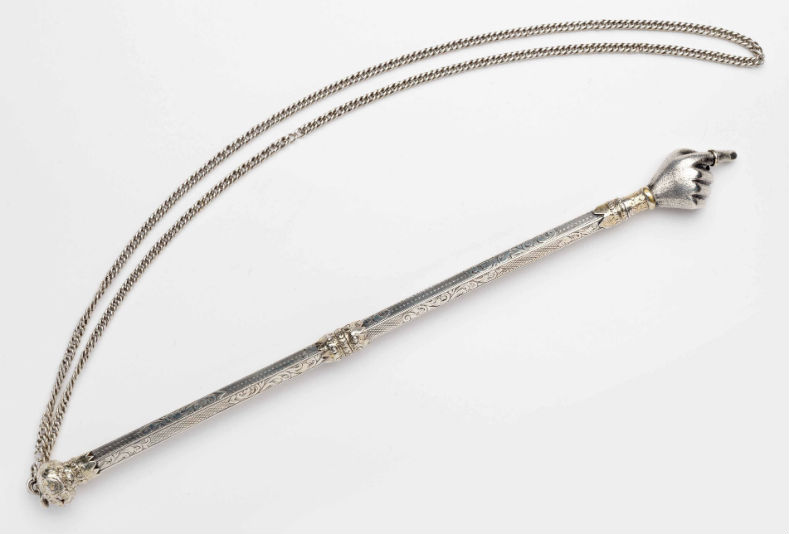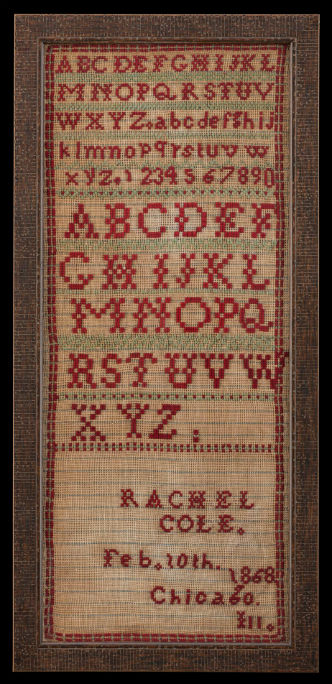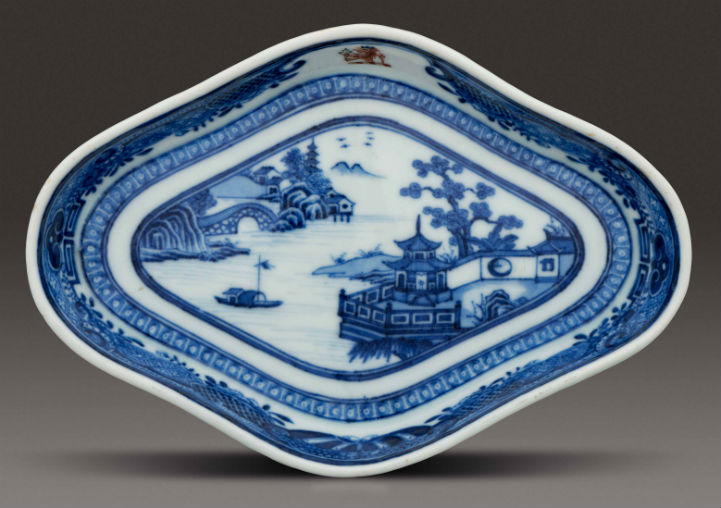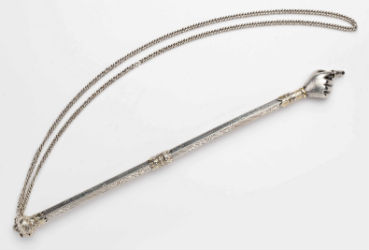
WILLIAMSBURG, Va. – The Colonial Williamsburg Foundation has recently added several important objects of Judaica to its collections: a sterling silver and gold Kiddush cup and a silver and gold yad, or Torah pointer.
These mark the first such objects in the Foundation’s holdings and exemplify the concerted efforts in recent years by the curators to acquire objects and address the stories of all early Americans while remaining true to their long-standing strength in British and American decorative arts. Additionally, objects that represent the early Anglo-American experience have also been acquired. These include an alphabet sampler created by a Jewish schoolgirl that is unique both for who made it and where it was created, as well as Chinese porcelain pieces that were owned by prominent London Jewish families.
“The Colonial Williamsburg Foundation sees the objects in its collections as documents of the people, places, and events of the past,” said Ronald L. Hurst, the foundation’s chief curator. “Because we use these objects to tell the compelling stories of early Americans, we seek to acquire things that speak to the full range of their experiences, whatever their race, religion, gender, age or cultural ethnicity may have been. These latest acquisitions mark important steps toward that goal.”
The silver objects are noteworthy additions to the collections as they represent a faith that was more prevalent in early America than most people realize today. They also span the realms of public and private worship in the Jewish religion. Kiddush cups are used both as part of family worship at home and as part of congregational worship, while the yad is used in congregational worship in a synagogue. The Colonial Williamsburg curators know that these specific examples are representative of what was owned and used in early America.
The yad, which literally means “hand,” can be interpreted as a representation of the hand of God and is used as a pointer during Torah readings, which allows the rabbi to follow the text without physically touching the sacred scrolls. The chain on the yad (above) was used to suspend it from the Torah scrolls when not in use. This example, made in Birmingham, England, between 1843-1844, is made of silver with gold gilding, which was the predominant material used to make yads since the early 1600s. It features a long wand of quadrangular shape that is engine-turned and engraved with foliage and has a media band also flanked by foliage. One end of the yad has a foliate-engraved knob with a suspension ring and hanging chain. The other end has an applied cast hand with an extended index finger wearing a ring. There are traces of gilding on the hand.
The Kiddush cup, which is used while reciting the blessing over wine (the Kiddush), is part of the commandment from the Torah to sanctify the Sabbath (Shabbat). Before the Friday night meal on the eve of Shabbat, the tradition dictates that a family’s Kiddush cup is filled with wine and held as the blessing is spoken, usually by the head of the household. Few ceremonial Jewish objects from the early Anglo-American world are known today. This Kiddush cup, probably made by William Harrison I (active ca. 1758-1781) in London about 1775, was the first piece of silver Judaica to be added to the Colonial Williamsburg collection. It is an elegant example with a circular stepped foot and a tapered stem that supports an egg-shaped cup with a gilded interior. It is engraved with three lines of Hebrew, “Remember the Sabbath day, and sanctify it,” within a shield suspended from a bow-knot and flanked by slender foliate sprays.

Also providing a glimpse into the Jewish experience in the early Anglo-American world, are a recently acquired schoolgirl sampler and Chinese porcelain objects:

The alphabet sampler by Rachel Cole (1854-1922) is an important addition to the textile collections. The most significant facet of this unique object’s story is its maker. Rachel Cole, who was born on Aug. 18, 1854, in Chicago, was the daughter of one of the city’s earliest Jewish families. Her mother, Sarah Frank, was an immigrant from Germany, her father, Samuel Cole, was an immigrant from Austria who was a co-founder of the Kehilath Anshe Ma’ariv (K.A.M.) congregation, which became Chicago’s first Jewish synagogue. Samuel Cole was also the president of the congregation for approximately one year. The sampler, which Rachel may have made at the K.A.M. school where she studied after graduating from one of Chicago’s public schools, is also unique as it is the only identified sampler marked “Chicago,” and one of just a handful of known samplers created by Jewish schoolgirls. The colorful sampler is marked with the place name of Chicago, Illinois, and with the date 1868. Few, if any, samplers from Chicago are known to survive, probably because of the Great Chicago Fire of 1871, which destroyed much of the city. Cole lived within just blocks of the approximately 3.3 miles of area consumed by the conflagration.
The prominent Sephardic Jewish D’Aguilar family were London merchants and sugar planters in the 18th century. This hard-paste porcelain stand, made in Jingdezhen, China, around 1795, is decorated with the family’s crest and is from just one of several armorial services that was ordered by the family. Most likely it was owned by Solomon, the fifth son of Don Diego D’Aguilar.

Also made in Jingdezhen, China, around 1805, is this hard-paste porcelain cup and saucer that is decorated with the coat of arms of Neilson impaling Goldsmid.

Aaron Goldsmid was a merchant in Hamburg and left there in 1765 to settle in London and establish the firm of Aaron Goldsmid & Son. Aaron’s second son, Asher, helped establish Mocatta & Goldsmid, which was a bullion-brokerage firm to the Bank of England. The Goldsmid family was known for its philanthropy and financier endeavors throughout the 18th and 19th centuries. It is most likely that this cup and saucer were made for a daughter or niece of Asher Goldsmid.


